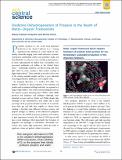Oxidative Dehydrogenation of Propane in the Realm of Metal–Organic Frameworks
Author(s)
Korzynski, Maciej Damian; Dinca, Mircea
Downloadacscentsci.7b00013.pdf (1.600Mb)
PUBLISHER_POLICY
Publisher Policy
Article is made available in accordance with the publisher's policy and may be subject to US copyright law. Please refer to the publisher's site for terms of use.
Terms of use
Metadata
Show full item recordAbstract
Propylene (propene) is one of the most important feedstocks in the chemical industry. It is a starting material for the synthesis of a wide variety of commodity chemicals ranging from small molecules (cumene, isopropanol, acrylonitrile, acrylic acid, propylene oxide, and butyraldehyde) to polymers (most notably, polypropylene). In 2013, approximately 85 million tons of propylene were processed worldwide—14 million in the United States alone.(1, 2) Traditionally, propylene is produced along with other light olefins by steam cracking or fluid catalytic cracking of higher hydrocarbons.(3) These methods are not ideal as the costs of the starting materials escalate and due to poor selectivity increasing production, purification, and energetic costs.
Date issued
2017-01Department
Massachusetts Institute of Technology. Department of ChemistryJournal
ACS Central Science
Publisher
American Chemical Society (ACS)
Citation
Korzyński, Maciej Damian, and Dincă, Mircea. “Oxidative Dehydrogenation of Propane in the Realm of Metal–Organic Frameworks.” ACS Central Science 3, 1 (January 2017): 10–12 © 2017 American Chemical Society
Version: Final published version
ISSN
2374-7943
2374-7951